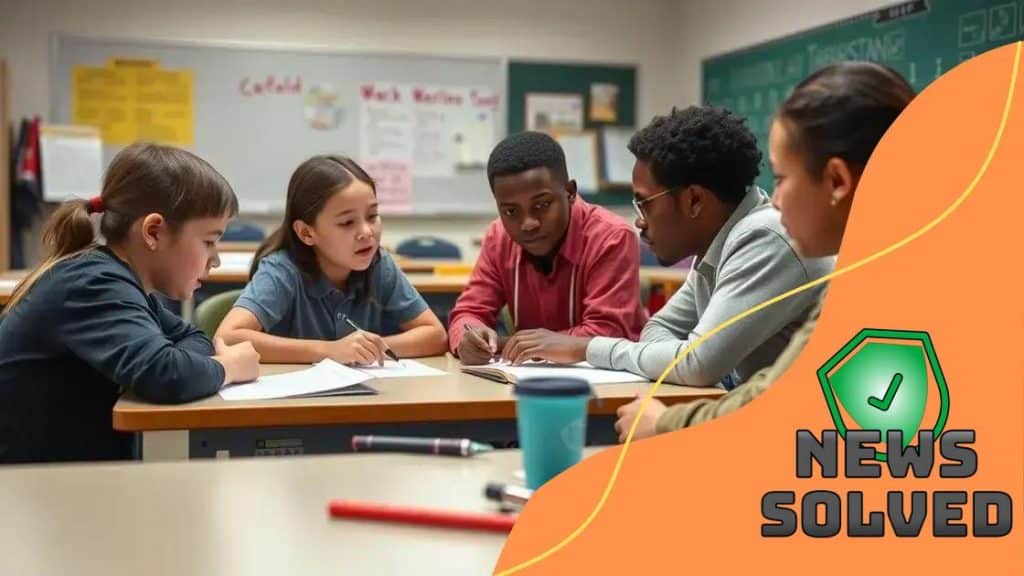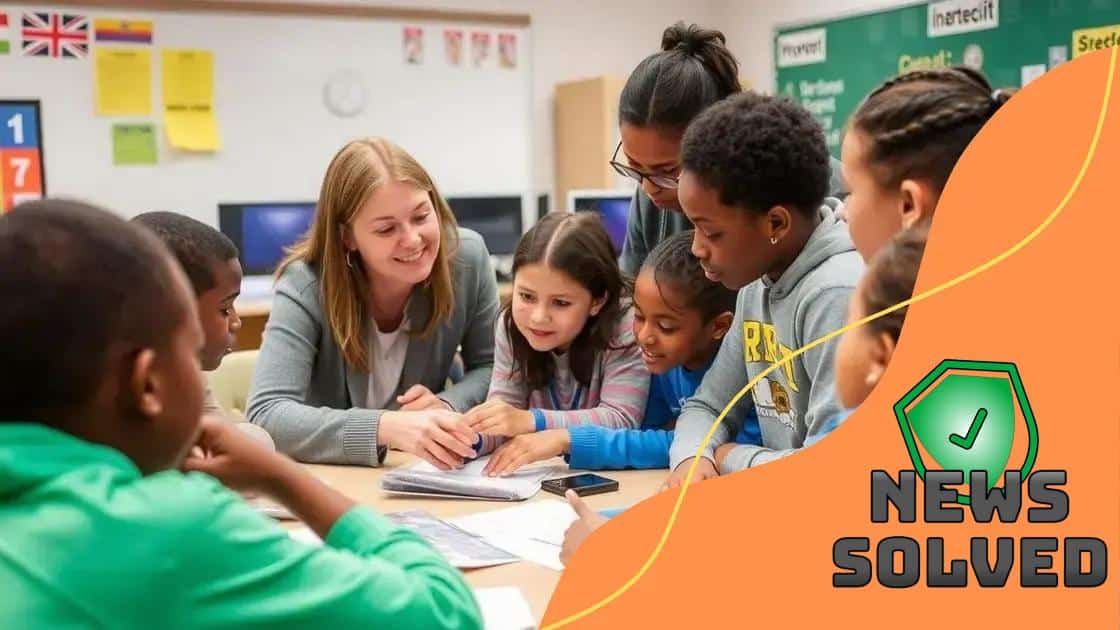How to integrate critical thinking and problem-solving in education

Advertisements
Integrating critical thinking and problem-solving in education equips students with essential skills for making informed decisions and tackling real-world challenges effectively.
How to integrate critical thinking and problem-solving in education is a question that many educators grapple with today. By fostering these skills, we can prepare students better for the complexities of modern life.
Advertisements
Understanding critical thinking and problem-solving
Understanding critical thinking and problem-solving is essential in today’s education system. These skills empower students to analyze information, make decisions, and tackle real-world challenges.
Critical thinking involves questioning assumptions, evaluating evidence, and considering different viewpoints. It encourages learners to seek clarity and depth in their understanding. By engaging in this process, students can become more adaptable and skilled at navigating complex situations.
Key Elements of Critical Thinking
Here are some vital components:
Advertisements
- Analysis: Examining arguments and situations critically.
- Interpretation: Understanding and explaining the meaning of information.
- Evaluation: Assessing the credibility of sources and arguments.
- Problem-solving: Developing solutions by applying logical reasoning.
Problem-solving complements critical thinking, allowing students to apply their analytical skills to concrete issues. This approach involves defining a problem, brainstorming solutions, and implementing the best options. By enhancing problem-solving skills, students learn to face challenges with confidence.
Ways to Foster Critical Thinking and Problem-Solving
In the classroom, teachers can promote these skills through various activities:
- Group Discussions: Encourage dialogue that examines diverse perspectives.
- Case Studies: Analyze real-life situations to apply theoretical knowledge.
- Project-Based Learning: Involve students in projects that require innovative solutions.
By integrating these activities, educators can cultivate an environment where critical thinking and problem-solving thrive. As students practice these skills regularly, they can better equip themselves for their future endeavors.
Benefits of integrating these skills
Integrating critical thinking and problem-solving skills into education brings numerous benefits. These skills promote deeper understanding and better preparation for future challenges.
When students learn to think critically, they enhance their ability to analyze information effectively. This skill is vital for making informed decisions in everyday life. By evaluating evidence and considering different perspectives, students become more well-rounded individuals.
Key Benefits
Here are some notable advantages:
- Improved Decision-Making: Students learn to weigh options and make thoughtful choices.
- Enhanced Creativity: Problem-solving activities stimulate creativity, encouraging innovative thinking.
- Greater Accountability: With critical thinking, students take ownership of their learning journey.
- Specific Skill Development: These skills are not just academic; they apply to personal and professional settings as well.
By fostering these abilities, educators prepare students for real-world applications. For instance, when students engage in group projects, they practice collaboration and communication while applying critical thinking. This experience in teamwork helps them navigate future work environments.
Additionally, critical thinking and problem-solving lead to better academic performance. Students who develop these skills often excel in tests and assignments. They learn to approach tasks systematically, breaking them down into manageable parts.
Overall Impact
The integration of these skills into the curriculum promotes lifelong learning. Students who think critically and solve problems are more likely to pursue knowledge even outside of formal education. This mindset empowers them to adapt and thrive in various situations.
Strategies for educators to implement

Implementing critical thinking and problem-solving strategies in education involves various effective methods. Educators play a crucial role in fostering these skills and creating an engaging learning environment.
One impactful strategy is to incorporate project-based learning. This approach allows students to work on real-world problems, encouraging them to think critically as they develop solutions. By collaborating on projects, students also enhance their teamwork skills.
Effective Teaching Strategies
Here are some practical techniques:
- Socratic Questioning: Use open-ended questions to stimulate discussion and promote deeper thought.
- Debates: Organize debates on relevant topics to encourage students to formulate and defend their viewpoints.
- Role-Playing: Create scenarios where students must solve problems from different perspectives to gain insight.
- Case Studies: Analyze real-life cases that require critical assessment and strategic thinking.
Another effective strategy is to integrate technology into lessons. Digital tools can facilitate interactive learning experiences that motivate students to engage critically with the content. For example, online simulations and educational games can challenge students to apply their knowledge and make decisions in a virtual environment.
Educators can also promote a growth mindset by encouraging students to view challenges as opportunities for learning. This mindset shifts the focus from simply finding the right answer to exploring multiple pathways for solutions. When students understand that making mistakes is part of the learning process, they are more likely to take risks and think creatively.
Real-life applications in the classroom
Real-life applications of critical thinking and problem-solving in the classroom help students connect their learning to the world around them. By seeing the relevance of these skills, students become more engaged and motivated.
One way to incorporate real-life scenarios is through experiential learning. Students can participate in community projects where they must evaluate needs and develop plans. This not only builds their problem-solving skills but also fosters a sense of responsibility and connection to their community.
Practical Examples
Here are some effective practices:
- Service Learning: Students work on projects that address community issues, combining classroom learning with practical problem-solving.
- Simulations: Use role-playing to mimic situations such as business negotiations or environmental crises, allowing students to navigate challenges.
- Field Trips: Visits to local businesses or organizations can illustrate how critical thinking is applied in various careers.
- Guest Speakers: Invite professionals who can share how they use critical thinking in their jobs, providing relatable success stories.
Additionally, teachers can design problem-based learning activities that require students to solve authentic problems. For instance, students might work on creating a sustainable garden at school, using mathematics to measure space, science to understand ecosystems, and art to design the layout.
When students apply their knowledge to real-world situations, they develop a deeper understanding of the subject matter. They learn to think critically about outcomes and make decisions based on evidence. This hands-on approach prepares them for future challenges in their careers and personal lives.
Assessing student growth in these areas
Assessing student growth in critical thinking and problem-solving is essential for understanding their progress. It helps educators identify where students excel and where they may need more support. Effective assessment methods can guide instruction and enhance learning outcomes.
One way to assess these skills is through performance-based assessments. These assessments require students to demonstrate their thinking in real-world scenarios. For example, students might be asked to solve a complex problem or present a project that showcases their ability to think critically.
Assessment Techniques
Here are several effective assessment strategies:
- Rubrics: Use clear rubrics to evaluate students’ critical thinking and problem-solving processes, focusing on criteria such as creativity, analysis, and the effectiveness of solutions.
- Peer Assessment: Encourage students to assess each other’s work, fostering collaboration and deeper understanding of criteria.
- Self-Reflection: Have students reflect on their learning experiences and the strategies they used to overcome challenges, promoting metacognitive skills.
- Portfolio Assessment: Collect student work over time to showcase their growth and provide a comprehensive view of their skills.
Another key technique is observational assessment. Teachers can observe student interactions during group work or discussion sessions. This practice allows educators to see how students engage with peers, express ideas, and apply critical thinking skills in real-time.
Additionally, standardized tests can provide baseline data on students’ skills. However, these should be used alongside other methods for a more complete picture. It is important to remember that traditional tests often do not accurately reflect a student’s ability to think critically or solve problems creatively.
FAQ – Questions about integrating critical thinking and problem-solving in education
Why is critical thinking important in education?
Critical thinking helps students analyze information, make sound decisions, and apply knowledge to real-world situations.
How can teachers assess students’ problem-solving skills?
Teachers can use performance-based assessments, peer evaluations, and self-reflections to evaluate problem-solving skills effectively.
What are some real-world applications of these skills in the classroom?
Real-world applications include project-based learning, service learning, and case studies that connect classroom learning to everyday challenges.
How can parents support critical thinking at home?
Parents can encourage critical thinking by asking open-ended questions, promoting discussions about daily events, and engaging in problem-solving activities together.





